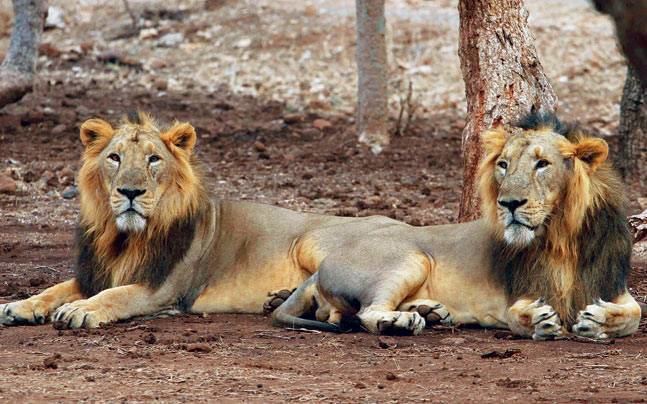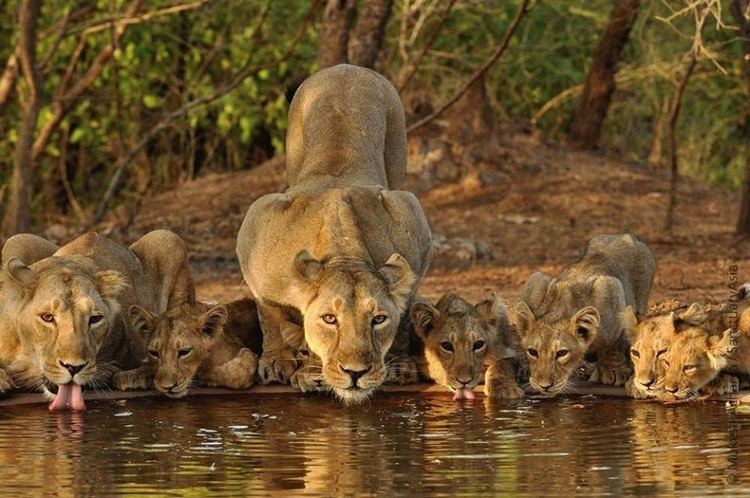Location Madhya Pradesh, India Established 1981 | Area 900 km² | |
 | ||
Kuno wildlife sanctuary
Kuno Wildlife Sanctuary or Palpur-Kuno Wildlife Sanctuary (between latitudes of 25°30'- 25°53'N & longitude of 77°07'-77°26'E) lies in the Sheopur district of north western Madhya Pradesh, a state in central India. It is about 200 kilometres from Gwalior.
Contents
- Kuno wildlife sanctuary
- Reintroduction of Asiatic lions
- Feral cattle
- Reintroduction of cheetahs
- On hold
- References

An area of 344.686 square kilometres was set aside as a wildlife sanctuary in 1981. Since then this has been elevated to the Kuno Wildlife Division with an additional area of 900 square kilometres as a buffer area around the sanctuary. The park is home to many species of wild animals including Indian wolves, monkeys, Indian leopards and nilgai.

Reintroduction of Asiatic lions

Wildlife Institute of India researchers confirmed that the Palpur-Kuno Wildlife Sanctuary is the most promising location to re-establish a free ranging population of Asiatic lions and certified it ready to receive its first batch of translocated lions from Gir Wildlife Sanctuary where they are highly overpopulated. There are large scale deaths in the population annually because of ever increasing competition due to animal overcrowding. Asiatic lion prides require large territories but there is limited space at Gir wildlife sanctuary, which is boxed in on all sides by heavy human habitation.

The Kuno Wildlife Sanctuary was selected as the reintroduction site for the endangered Asiatic lion because it is in the former range of the lions before it was hunted into extinction in about 1873. It was selected following stringent international criteria and internationally accepted requirements & guidelines developed by IUCN/SSC Reintroduction Specialist Group and IUCN/SSC Conservation Breeding Specialist Group which are followed before any reintroduction attempt anywhere in the world.

Currently the Asiatic Lion Reintroduction Project is underway. The lions are to be reintroduced from Gir Wildlife Sanctuary in the neighboring Indian state of Gujarat where they are currently overpopulated. This has involved the displacement of twenty four villages of the Sahariya tribe, which had lived in the remote core area set aside for the reintroduction of the Asiatic lions, who agreed to move out.

As the state government of Gujarat was refusing to relocate the Asiatic lions to the sanctuary, this ensued a long battle. Finally on 18 April 2013, the Supreme Court of India gave a verdict that asked the Gujarat government to complete the translocation of the Asiatic lion within six months.

Earlier experts held the view that since Kuno Sanctuary already had Bengal tigers present, introduction of the Asiatic lion may lead to conflict between the two apex predators. Kuno Sanctuary acts as a buffer zone for tigers from Ranthambore. Usually sub-adult male tigers who cannot establish a territory of their own after being driven out by dominant male tigers reside in buffer areas. Currently a tiger named T-38 from Ranthambore is said to be residing in Kuno Sanctuary.[9]
On 22 April 2015, the Union government has admitted that Madhya Pradesh will have to enlarge the wildlife sanctuary's size in order to translocate the Asiatic lions to Palpur-Kuno from Gujarat's Sasan Gir, which is the first time the government accepted the sanctuary needs to be enlarged. However, that would require relocating several big villages.
Feral cattle
Feral zebu cattle also roam the sanctuary, left behind by the relocated Sahariya tribal herders. The cattle are intended to serve as buffer prey for Asiatic lions until wild prey populations are revived.
Reintroduction of cheetahs
Currently, wildlife experts have shortlisted three regions which have the potential to support cheetah populations. The Kuno-Palpur Wildlife Sanctuary and Nauradehi Wildlife Sanctuary both in Madhya Pradesh and the Shahgarh bulge landscape in Jaisalmer, Rajasthan have been declared potentially suitable for the reintroduction of the cheetah. The Kuno-Palpur Wildlife Sanctuary in Madhya Pradesh has the potential to hold populations of all four of India's big cats the tiger, the leopard, the Asiatic lion as well as the cheetah, all four of which have coexisted in the same habitats historically before they were wiped out due to over hunting and habitat destruction. Since the Shahgarh Landscape is fenced along the Indo-Pak border region, the addition of more fencing will ensure adequate protection for the cheetah population. The Nauradehi Wildlife Sanctuary is part of a much larger forested landscape (5500 km2 ) which can host the cheetah as well.
Kuno-Palpur Wildlife Sanctuary is a part of the Sheopur-Shivpuri forested landscape, which had the second largest area (6800 km2) amongst the surveyed sites for reintroduction of cheetahs. This site was rated high on the priority list for considering because a lot of restorative investment has already been made here for introducing the Asiatic lions. The protected area was estimated to have a current carrying capacity to sustain 27 cheetah, which could be enhanced to over 32 individuals by addition of some more forested areas (120 km2) to the Kuno Sanctuary and managing the surrounding 3,000 km2 establishes itself within the sanctuary, dispersers would not preclude the reintroduction of the Asiatic lion once the cheetah population is established and the two introductions would complement each other. Kuno offers the prospect of all the four large forest cats/felids of India to coexist as they historically did in the past.
Kuno-Palpur Wildlife Sanctuary has been shortlisted by Wildlife Institute of India (WII) and Wildlife Trust of India (WTI) as one of the last remaining habitats of the cheetah (Acinonyx jubatus) in India and is proposed as one of the sites for the reintroduction of the species in India. Asiatic cheetahs (Acinonyx jubatus venaticus) that used to occur here are now locally extinct in India and elsewhere, except a very small critically endangered and fragmented population of last few, estimated to be below 100, thought to be surviving only in the central desert of Iran. Thus cheetah experts from around the world have advised India to import and introduce the cheetah from Africa as genetically it is identical to the ones found is Asia, as some genetic studies would suggest that the Asian population had separated from the African relatively recently only 5000 years ago which is not enough for a subspecies level differentiation.
However, a much more detailed five-year genetic study involving the gathering of DNA samples from the wild, zoos and museums in eight countries published in Molecular Ecology (Journal) on 8 January 2011, concluded that African and Asiatic cheetahs are genetically very distinct. Molecular sequence comparisons suggest that they separated between 32,000 and 67,000 years ago and that subspecies level differentiation had occurred.
On hold
Reintroduction project with cheetahs imported from Africa is currently put on hold by India's Supreme Court in favor of translocation of native Asiatic lions.
As of May 2012 the Indian Supreme Court has put the project of importing cheetahs from Africa and reintroducing them in India on hold. Some Conservationists have been fighting a legal battle in the Indian Supreme Court to get the State Government of Gujarat to break its monopolizing of wild Asiatic lions and release a few overpopulated prides of Asiatic lions spilling out of Gir National Park for reintroduction in the Kuno Wildlife sanctuary in the neighbouring state of Madhya Pradesh which was prepared for them after relocating over 24 villages out of the forest. In the past, for last two decades the State Government of Gujarat had concocted every possible reason to maintain its monopoly on wild Asiatic lions and the tourism revenue generated by them and of recent Gujarat's legal council had put forward the argument that Kuno Wildlife Sanctuary is being used for the introduction of African cheetahs which might take several years to fully settle down and repopulate the area and hence reintroduction of Asiatic lions should only be done after that, this scared the conservationists that Gujarat will use this pretext to delay the reintroduction of native Asiatic lions by many more decades using the cheetah argument. Indian Supreme court has taken note of the arguments put forth by some Indian conservationists that importing African cheetahs for reintroduction in India is misguided as it is against IUCN reintroduction guidelines and no clearance had been sought from India's National Board for Wildlife. The Indian Supreme Court has put the project on hold till further notice asking for clearance from India's National Board for Wildlife, meantime it has fast tracked the case for reintroduction of Asiatic lions to Kuno Wildlife Sanctuary and is hearing it every Monday.
Senior advocate PS Narasimha, court-appointed adviser and the amicus curiae in the Asiatic lion relocation case in India's Supreme Court, filed an application seeking a stay on the implementation of African cheetah reintroduction project in India. The Indian Supreme court granted the stay and the matter has been scheduled for further hearing in July 2012 after the court returns from vacation. During its hearings, the Bench was informed that India's Ministry of Environment and Forests (MoEF) has decided to introduce the South African cheetah (Acinonyx jubatus jubatus) from Namibia into Kuno Wildlife Sanctuary in the Indian state of Madhya Pradesh, the same proposed habitat being developed as the second home for the translocation of Asiatic lions from Gir Wildlife Sanctuary in the neighboring Indian state of Gujarat which did not want to shift any Asiatic lions out of the state. Narasimha said the proposal for reintroduction of African cheetah "has not been either placed before the Standing Committee of India's National Board for Wildlife, nor has there been a considered decision taken in this regard". He stated in an application that "scientific studies show that the African Cheetahs and Asian Cheetahs are completely different, both genetically and also in their characteristics" and the reintroduction of African cheetah in India was also against the International Union for the Conservation of Nature (IUCN) guidelines on translocation of wildlife species. "In fact, the (IUCN) guidelines categorically warn against the introduction of alien or exotic species. The African cheetah obviously never existed in India. Therefore, it is not case of intentional movement of an organism into a part of its native range," the application stated. Asiatic cheetahs became extinct in India in the 1950s, In the past, India's last recorded cheetah in the wild was said to have been shot in the Rewa area of Madhya Pradesh in the late 1940s. It was mentioned that the introduction of alien or exotic species is universally shunned by wildlife experts and "in fact countries such as South Africa, Australia are spending huge amount of funds to eradicate and remove exotic wildlife species from wilderness areas or wild habitats". Narasimha also sought a direction of India's Ministry of Environment and Forests (MoEF) to produce before the apex court all relevant records and decisions relating to introduction of cheetahs. He said the Indian cheetah in genetic composition is a different animal than the African cheetah and a different subspecies altogether and "therefore one cannot be introduced in place of the other". Conservationists say fewer than 100 of the critically endangered Asiatic cheetah subspecies remain only in Iran, roaming the central deserts. The vast majority of the 10,000 cheetahs left in the world are in Africa.
